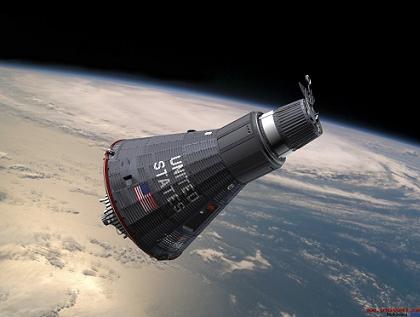Mercury-Atlas

Mercury-Atlas was a subprogram of Project Mercury that included most of the flights and tests using the Atlas LV-3B launch vehicle. The Atlas was also used for one Mercury flight under the Big Joe subprogram.
The Mercury mission numbering system was: a two-letter designation marking the launch vehicle type, followed by a dash, then a number designating the flight/test number. The Atlas launch vehicles used for Project Mercury were given a two- or three-digit number followed by a "-D", indicating that they were the "D" version of the Atlas.
As a subset of Project Mercury, the Atlas D missile was considered a good choice since it was the only launch vehicle in the US arsenal that could put the spacecraft into orbit. The Atlas D rocket as configured for Mercury launches was 94 feet tall, 10 feet in diameter and weighed 260,000 lbs. when loaded with fuel. It also had the necessary payload capacity of 3,000 lbs., which was enough for Mercury capsule and pilot.
However, its reliability was far from perfect in its military form and therefore could not be qualified to carry astronauts. NASA did not want to wait on a new rocket design and subsequent testing program or for the next generation of Titan II rocket to move the Mercury project forward, so Convair had to make significant changes to render the Atlas D safe and reliable for human launches. Also, NASA felt that the Atlas D stage-and-a-half launch configuration was preferable to the two stage Titan from a preflight check list perspective. Despite Atlas’s reliability issues, NASA had the benefit of conducting Project Mercury testing simultaneously with Atlas R&D, which provided very useful data sets as well as a test environment for modified equipment for Mercury launches.

Mercury-Atlas 6 (MA-6) was the first American orbital spaceflight, which took place on February 20, 1962. Piloted by astronaut John Glenn and operated by NASA as part of Project Mercury.
Mercury-Atlas 6 (MA-6) was the first American orbital spaceflight, which took place on February 20, 1962. Piloted by astronaut John Glenn and operated by NASA as part of Project Mercury. 
In all, Nine Mercury-Atlas’s launches were conducted; two unmanned suborbital flights, three unmanned orbital flights and four manned Mercury flights. All Atlas launches were conducted from Launch Complex 14 at Cape Canaveral Air Force Station, Florida with the last launch on May 15, 1963. NASA had originally planned to use leftover rockets to launch Gemini-Agena Target Vehicles. But an increase in funding in 1964 meant that the agency could afford to buy new Atlas rockets for Project Mercury.